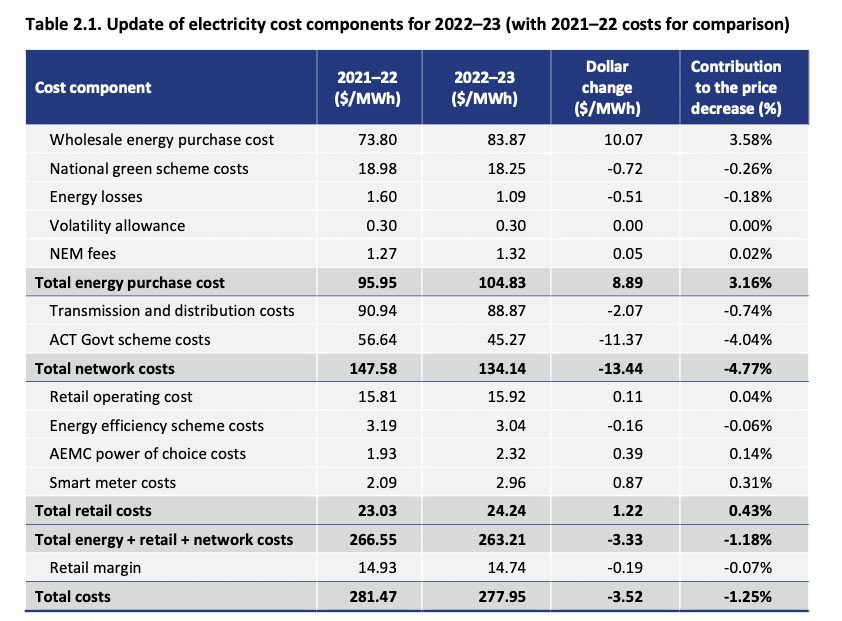Electricity users in the Australian Capital Territory will see average electricity costs fall by at least 1.25 per cent come 1 July, as the capital territory’s extensive contracts for 100 per cent renewable electricity shield its consumers from the chaos rippling through Australia’s energy markets.
On Monday, the ACT’s Independent Competition and Regulatory Commission – which regulates electricity tariffs in the ACT – announced regulated tariffs provided by government-owned retailer ActewAGL would fall in the next financial year.
Both households and businesses in Canberra stand to benefit from the lower electricity costs, even as consumers in most other states face bill hikes of up to 18 per cent, or more.
“The minimum average decrease of 1.25 per cent will translate to an annual bill saving of $23 for an average residential customer consuming 6,500kWh,” ACT ICRC senior commissioner Joe Dimasi said in a statement.
“For an average non-residential customer consuming 25,000kWh, the decrease in the annual bill will be $88.”
The ICRC says that the ACT will become the only jurisdiction in Australia to enjoy lower electricity prices – potentially the lowest in Australia – during a period of intense disruption and surging costs for oil, gas and coal.
“ACT is the only jurisdiction in the national electricity market where regulated tariffs will decline in 2022-23,” he said.
“The average annual bill for Canberrans on standing offers will be the lowest compared to the average standing offer bills faced by customers in New South Wales, Victoria, Queensland and South Australia.”
The ICRC said the fall was primarily thanks to fixed-price contracts the ACT government has signed to source an equivalent of 100 per cent of the territory’s electricity consumption from renewable energy sources.
“The price reduction is driven by the reduction in ACT Government scheme costs, which more than offset the increase in wholesale electricity costs. ACT Government scheme costs put downward pressure on prices this year,” the ICRC’s determination says.
“ACT Government scheme costs decreased because of a fall in the large-scale feed-in-tariff (FiT) support payments. Large-scale FiT support payment is the difference between the fixed contract price to renewable generators and the prevailing wholesale electricity prices,” the ICRC says.
“Because of an increase in wholesale electricity prices, the contract-for-difference payments to contracted generators decreased.”
The ICRC noted that the electricity price decrease would apply to consumers on regulated tariffs provided by ActewAGL – which commands a market share of more than 80 per cent in the ACT – and encouraged energy users to check to ensure they received the best deal from their electricity retailer.
“The regulated price decreases mentioned only apply to standing offer tariffs. We encourage consumers to regularly compare these tariffs to other offers that are in the market,” Dimasi added.
How the ACT’s electricity prices will change
ACT energy and emissions reduction minister Shane Rattenbury welcomed the fall in both prices and emissions while encouraging ACT households to continue to take up energy efficiency schemes being offered by the government.
“We’re very pleased that we continue to see the ACT’s energy prices be amongst the most affordable in the country, whilst at the same time helping the move to 100 per cent renewable electricity and reduce our greenhouse gas emissions by around 40 per cent,” Rattenbury said.
“That said, we encourage Canberrans to continue to take up the programs that are available from the ACT government.”
“There’s a range of programs to move away from some of the fossil fuel devices in your household to install solar, to drive energy efficiency so that we can continue to make sure that energy is affordable to households here in the ACT.”

As RenewEconomy reported last week, the ACT has secured fixed price electricity contracts as part of its commitment to supplying the entire territory with 100 per cent renewable electricity.
Under the renewables policy, the ACT signed contracts-for-difference with a range of solar and wind farms, which sees the ACT pay no more, and no less, than around $90 per megawatt-hour for wholesale electricity.
Because wind and solar projects have no fuel costs, they are not subject to the same cost fluctuations that can be experienced by coal and gas generators, and so can offer fixed wholesale price contracts.
The contracts-for-difference see ACT energy users top-up payments to contracted wind and solar projects when wholesale electricity prices are below the fixed contract price, but when wholesale electricity prices exceed the fixed contract price, the wind and solar projects are required to refund the excess to consumers.
While it ordinarily sees ACT households pay a small premium for their renewable electricity supplies, the contracts also shield consumers from any surge in wholesale prices – such as those currently impacting Australian electricity markets.
New South Wales wholesale electricity prices averaged $320 per MWh in May and are currently averaging more than $475 per MWh in June so far.
While these high prices have contributed to electricity price increases in other jurisdictions – notably New South Wales, South Australia, and South-east Queensland, which have all seen their benchmark electricity tariffs increased by the Australian Energy Regulator – ACT electricity users will see their costs fall, thanks almost entirely to the renewable energy contracts.
The ICRC found that ACT consumers would also benefit from lower transmission and distribution costs, contributing 0.74 per cent to the overall reduction, while retailer margins were also slightly lower.
Shortly following the federal election, the AER published its latest’ default market offer’ determination – setting the benchmark electricity price consumers in New South Wales, South-east Queensland and South Australia.
The determination saw the benchmark electricity price in New South Wales increase by between 8.5 and 14.1 per cent, increased by 11.3 per cent in south-east Queensland and 7.2 per cent in South Australia.
The AER said these increases had been caused by higher costs for coal and gas generation and the impacts of an increase in the frequency of outages at large thermal generators.










